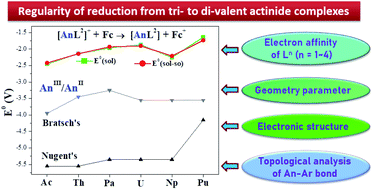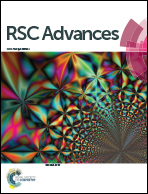Redox and structural properties of accessible actinide(ii) metallocalixarenes (Ac to Pu): a relativistic DFT study†
Abstract
The redox properties of actinides play a significant role in manipulating organometallic chemistry and energy/environment science, for being involved in fundamental concepts (oxidation state, bonding and reactivity), nuclear fuel cycles and contamination remediation. Herein, a series of trans-calix[2]pyrrole[2]benzene (H2L2) actinide complexes (An = Ac–Pu, and oxidation states of +II and +III) have been studied by relativistic density functional theory. Reduction potentials (E0) of [AnL2]+/[AnL2] were computed within −2.45 and −1.64 V versus Fc+/Fc in THF, comparable to experimental values of −2.50 V for [UL1e]/[UL1e]− (H3L1e = (Ad,MeArOH)3mesitylene and Ad = adamantyl) and −2.35 V for [U(CpiPr)2]+/[U(CpiPr)2] (CpiPr = C5iPr5). The E0 values show an overall increasing trend from Ac to Pu but a break point at Np being lower than adjacent elements. The arene/actinide mixed reduction mechanism is proposed, showing arenes predominant in Ac–Pa complexes but diverting to metal-centered domination in U–Pu ones. Besides being consistent with previously reported those of AnIII/AnII couples, the changing trend of our reduction potentials is corroborated by geometric data, topological analysis of bonds and electronic structures as well as additional calculations on actinide complexes ligated by tris(alkyloxide)arene, silyl-cyclopentadiene and octadentate Schiff-base polypyrrole in terms of electron affinity. The regularity would help to explore synthesis and property of novel actinide(II) complex.



 Please wait while we load your content...
Please wait while we load your content...